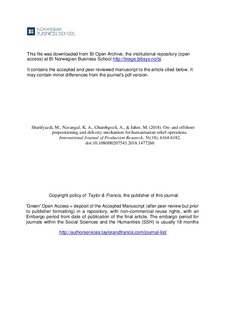On- and offshore prepositioning and delivery mechanism for humanitarian relief operations
Journal article, Peer reviewed
Accepted version
Permanent lenke
http://hdl.handle.net/11250/2581400Utgivelsesdato
2018Metadata
Vis full innførselSamlinger
- Publikasjoner fra CRIStin - BI [1015]
- Scientific articles [2181]
Originalversjon
International Journal of Production Research. 2018, 56 (18), 6164-6182. 10.1080/00207543.2018.1477260Sammendrag
Traditionally, international humanitarian organisations have used on-demand dispatch of disaster relief goods from regional logistics units (RLUs) for sudden onset disaster response. This paper investigates the improvements in efficiency and resilience of disaster relief operations by combining the existing method of onshore prepositioning of relief items in RLUs with offshore prepositioning of relief items on-board vessels and at seaport terminals. The problem is formulated as a linear programming model that incorporates different logistical costs, including inventory cost, replenishment cost, and transportation cost, to find the best combination of disaster relief methods. At the tactical level, the model determines how much and where disaster relief items need to be prepositioned. At the operational level, the model addresses how much and by which mode of transport the disaster relief items need to be transported to disaster points. The model is tested on 16 major disasters in Southeast Asia. The main finding is that offshore prepositioning can contribute to cost reduction and resilience without compromising on the speed or the scale of the response. The results also suggest that the benefits depend on the duration of the disaster emergency period and the ratio of offshore storage cost to onshore storage cost. On- and offshore prepositioning and delivery mechanism for humanitarian relief operations
